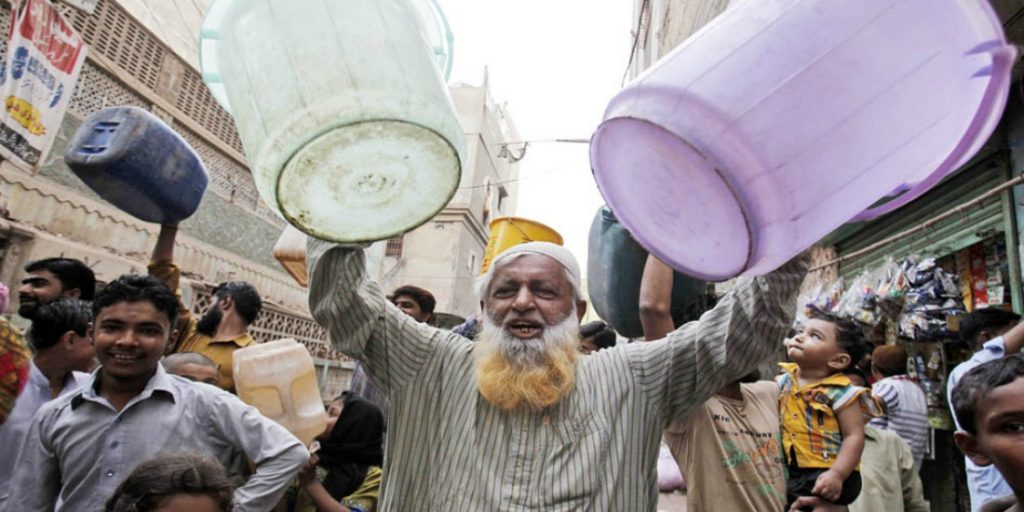Disclaimer*: The articles shared under 'Your Voice' section are sent to us by contributors and we neither confirm nor deny the authenticity of any facts stated below. Parhlo News will not be liable for any false, inaccurate, inappropriate or incomplete information presented on the website. Read our disclaimer.
This post is also available in: English (الإنجليزية) اردو (الأردية)
It is right to say Karachi is the largest city of Pakistan and contribute the greatest share in the GDP of Pakistan but that is another reality, Karachi is the city of problems and the problem of water shortage is the biggest problem for the people of Karachi because water is the basic necessity of life. Only 60% of the population has access to water through pipelines, many people have to wait in the lines of water service, this problem has also become alarming with the 4.5% growth rate of the population of Karachi annually.
According to Karachi water and sewerage board (KWSB), Karachi gets 546 Mgd water from Indus River and 100 Mgd from Hub dam, the hub dam is rain-fed due to this the supply of hub dam is fluctuate between 40-100 Mgd, in this way the amount of water supply becomes 646 Mgd and also inform us that three types of demand for water are found in Karachi, first for drinking and cooking purpose, for this approximate 25 Mgd water is required, second for domestic purpose, for this 700 Mgd is required and the last for Industrial and commercial purpose, for this 575 Mgd. That’s means, the total current approximate demand is 1300 Mgd; against this demand, the capacity of the current supply system is 646 Mgd, thus the total shortfall of water becomes 654 Mgd.

To fulfill the demand of water many techniques are used in Karachi that is not in the benefit of Karachi; First is very common, the citizens use underground water reserves by using boring, this process disturbs the water table and increases expenditures of citizens because the cost of water boring is lies between 600-800 rupees per feet and the water gets at least on 100 feet, second the industrial and commercial sector tries to influence the water regulating agencies by using bribes, due to this following results have come out; 161 unofficial hydrants are operating in Karachi, unauthorized diversion of water or theft is a common exercise in water supply system and administrative and management problems in KWSB.

So far, we were discussing the present condition of the water system in Karachi, but now we will be discussing, what project is about to complete to overcome the water shortfall and which types of measures will have to take for better management of water supply in Karachi. To overcome the shortfall of water, KWSB launched a K-IV project, it is bulk supply line from Kheenjar Lake, it will add 1200 Mgd in the total supply of water, the main beneficiary of this project will be the industrial sector but this project would be completed by 2025 that means, we would have to take other steps in the meanwhile of 2018 and 2025 unless the K-IV project becomes complete. According to KWSB, 30 percent of the water supply is lost due to the leakages in bulks and pipelines and technical problems, if we figure out this problem, it will save our approximately 190 Mgd water, for this process, we need two years.

Now we will discuss how KWSB can play a better role inequitable distribution and management; two things required, first we have to overcome the political interference in the institutional matters and second is that we have to declare the KWSB as a single umbrella agency, that monitors and provides guidelines to all the water supply agencies and constituent bodies including civil areas of cantonment boards and other land-owning agencies except their operational areas.

Now we will discuss what would be the condition of Karachi’s water supply management in the future, so for this, we analyze the national water policy 2018 of Pakistan, this policy emphasizes on making large, medium and small dams to store water and this policy also emphasize two major things for urban water management; first is the reuse and retreat of the water for domestic, agriculture and industrial purposes, the interesting thing in the Karachi retreatment process is, Karachi have 5 retreatment plants of water but only one is operating and its maximum capacity is 30 Mgd, and second is install water meters to reduce in water wastage, but one thing; for this process we have to develop better safety tax net because 62.5 percent of Karachi’s population lying on the poverty line or under.
In the case of Karachi, Arabian sea also a great source of water, the government may install desalination plants to receive fresh water, but for this method we need low-cost electricity, while in Karachi electricity unit cost is very high, because Pakistan gets most of the electricity from non-renewable resources, otherwise this method is not sustainable to get fresh water and we want to add one more thing, if all the treatment plants of drainage water are operated properly, so this thing would reduce sea pollution and make normal PH of sea water, that would reduce the cost of desalination process.
We can hope, the government has been endeavoring to change the status quo, but there has also a responsibility on every citizen is to create awareness in the society and education system to conserve the water and reduce in the wastage of water by using recycle and reusing techniques.


